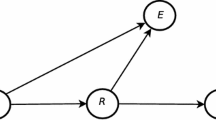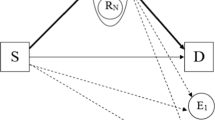Abstract
This paper investigates the impact of channel imperfection and multiple eavesdroppers on the secrecy performance of dual-signal selection in amplify and forward-relay systems. This paper derives the lower-bound closed-form expressions of the dual-signal selection for the secrecy outage probability. This work also derives the asymptotic secrecy outage probability expressions of the dual-signal selection for four scenarios and quantifies the secrecy diversity order. Using the asymptotic analysis, we observe that the dual-signal selection provides the secrecy diversity order gain of \({\mathrm{UM}}_{\mathrm{T}}\) compared to the conventional relay-signal scheme in the presence of channel imperfection. Finally, we find that the parameters of eavesdropper such as \({{\mathrm{E}}}\) and \({\mathrm{M}}_{{\mathrm{E}}}\) do not significantly affect the secrecy performance of the dual-signal selection.






Similar content being viewed by others
References
Wyner, A. (1975). The wire-tap channel. The Bell System Technical Journal, 54(8), 1355–1387.
Csiszar, I., & orner, J. (1978). Broadcast channels with confidential messages. IEEE Transactions on Information Theory, 24(3), 339–348.
Cheong, S., & Hellman, M. (1978). The Gaussian wire-tap channel. IEEE Transactions on Information Theory, 24(4), 451–456.
Alves, H., Souza, R., Debbah, M., & Dennis, M. (2012). Performance of transmit antenna selection physical layer security schemes. IEEE Signal Processing, 19(6), 372–375.
Yang, N., Yeoh, P., Elkashlan, M., Scholber, R., & Collings, I. (2013). Transmit antenna selection for security enhancement in MIMO wiretap channels. IEEE Transactions on Communications, 61(1), 144–154.
Ferdinand, N., Benevides da Costa, D., & Latva-Aho, M. (2013). Effects of outdated CSI on the secrecy performance of MISO wiretap channels with transmit antenna selection. IEEE Communications Letters, 17(5), 864–867.
Faruk, A., & Kucur, O. (2019). Secrecy outage probability of conventional and modified TAS/Alamouti-STBC schemes with power allocation in the presence of feedback errors. IEEE Transactions on Vehicular Technology, 68(3), 2609–2623.
Moualeu, J., Costa, D., Martinez, F., Hamouda, W., Ngatched, T., & Dias, U. (2019). Transmit antenna selection in secure MIMO systems over \(\alpha -\mu \) fading channels. IEEE Transactions on Communications, 67(9), 6483–6498.
Xiong, J., Tang, Y., Ma, D., Xiao, P., & Wong, K. (2015). Secrecy performance analysis for TAS-MRC system with imperfect feedback. IEEE Transactions on Information Forensics and Security, 10(8), 1617–1629.
Hu, J., Cai, Y., Yang, N., & Yang, W. (2015). A new secure transmission scheme with outdated antenna selection. IEEE Transactions on Information Forensics and Security, 10(11), 2435–2446.
Huang, Y., Al-Qahtani, F., Duong, T., & Wang, J. (2015). Secure transmission in MIMO wiretap channels using general-order transmit antenna selection with outdated CSI. IEEE Transactions on Communications, 63(8), 2959–2971.
Yang, N., Suraseera, H., Collings, I., & Yuen, C. (2013). Physical layer security of TAS/MRC with antenna correlation. IEEE Transactions on Information Forensics and Security, 8(1), 254–259.
Si, J., Li, Z., Cheng, J., & Zhong, C. (2019). Secrecy performance of multi-antenna wiretap channels with diversity combining over correlated Rayeigh fading channels. IEEE Transactions on Wireless Communications, 18(1), 444–458.
Si, J., Li, Z., Cheng, J., & Zhong, C. (2019). Asymptotic secrecy outage performance for TAS/MRC over correlated Nakagami-m fading channels. IEEE Transactions on Communications, 67(11), 7700–7714.
Yang, L., Hasna, M., & Ansari, I. (2018). Physical layer security for TAS/MRC systems with and without co-channel interference over \(\eta -\mu \) fading channels. IEEE Transactions on Vehicular Technology, 67(12), 12421–12426.
Lee, D. (2020). Secrecy performance of user and antenna selection with channel estimation inaccuracy. IEEE Trans. Veh. Tech., 69(4), 4533–4536.
Shim, K., Do, N., & An, B. (2017). Performance analysis of physical layer security of opportunistic scheduling in multiuser multirelay cooperative networks. MDPI, 17(2), 1–19.
Kundu, C., Ghose, S., & Bose, R. (2015). Secrecy outage of dual-hop regenerative multi-relay system with relay selection. IEEE Transactions on Wireless Communications, 14(8), 4614–4625.
Guo, Q., & Feng, W. (2019). Joint Relay and Eavesdropper selection strategy against multiple eavesdroppers over Nakagami-m fading channels in cooperative decode-and-forward relay networks. IEEE Access, 7, 37980–37988.
Jameel, F., Wyne, S., Nawaz, S., Ahmed, J., & Cumanan, K. (2018). “On the Secrecy Performance of SWIPT Receiver Architectures with Multiple Eavesdroppers,” Wireless Communications and Mobile Computing, pp.1-13.
Jindal, A., Kundu, C., & Bose, R. (2014). Secrecy outage of dual-hop AF relay system with relay selection without eavesdropper’s CSI. IEEE Communications Letters, 18(10), 1759–1762.
Fan, L., Lei, X., Yang, N., Duong, T., & Karagiannidis, G. (2016). Secure multiple amplify-and-forward relaying with cochannel interference. IEEE Journal of Selected Topics in Signal Processing, 10(8), 1494–1505.
Fan, L., Zhao, R., Gong, F., Yang, N., & Karagiannidis, G. (2017). Secure multiple amplify-and-forward relaying over correlated fading channels. IEEE Transactions on Communications, 65(7), 2811–2820.
Zhao, R., Lin, H., He, Y., Chen, D., Huang, Y., & Yang, L. (2018). Secrecy performance of transmit antenna selection for MIMO relay systems with outdated CSI. IEEE Transactions on Communications, 66(2), 546–559.
Lee, D. (2021). Secrecy analysis of relay-user selection in AS-AF systems over Nakagami fading channels. IEEE Transactions on Vehicular Technology, 70(3), 2378–2388.
Yang, N., Elkashlan, M., Lep, P., & Yuan, J. (2012). Multiuser MIMO relay networks in Nakagami-m fading channels. IEEE Transactions on Communications, 60(11), 3298–3310.
Lee, D. (2020). Outage probability of direct and relay signal selection over non-identical channel estimation error. Physical Communication, 38, 1–7.
Abramowitz, M., & Stegun, I. A. (1972). Handbook of Mathematical Functions with Formulas, Graphs, and Mathematical Tables, Dover.
Gans, M. J. (1971). The effect of Gaussian error in maximal ratio combiners. IEEE Transactions on Communication Technology, 19(4), 492–500.
Balakrishman, N., & Cohen, A. (1991). Order Statistics and Inference. Estimation Methods: Academic Press Inc.
Gradshteyn, I. S., & Ryzhik, I. M. (2007). Table of integrals, series, and products (7th ed.). Cambridge: Academic Press Inc.
Chen, Z., Yuan, J., & Vucetic, B. (2005). Analysis of transmit antenna selection/maximal-ratio combining in Rayleigh fading channels. IEEE Transactions on Vehicular Technology, 54(4), 1312–1321.
Acknowledgements
This work was supported by the National Research Foundation of Korea(NRF) grant funded by the Korea government(MSIT) (No. 2021R1A2C1092138)
Author information
Authors and Affiliations
Corresponding author
Additional information
Publisher's Note
Springer Nature remains neutral with regard to jurisdictional claims in published maps and institutional affiliations.
Rights and permissions
About this article
Cite this article
Lee, D. The impact of channel imperfection and multiple eavesdroppers on security of dual-signal selection in AF-relay systems. Wireless Netw 28, 1531–1540 (2022). https://doi.org/10.1007/s11276-022-02907-z
Accepted:
Published:
Issue Date:
DOI: https://doi.org/10.1007/s11276-022-02907-z




